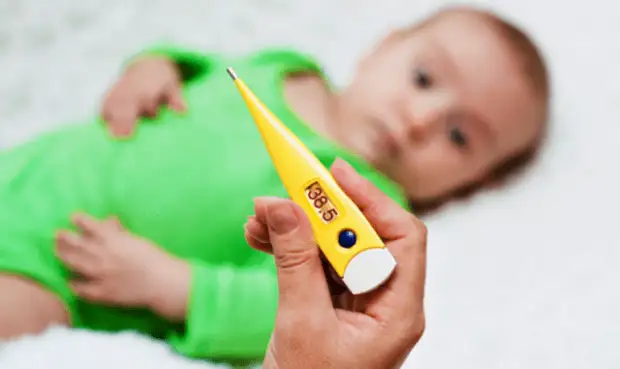
Are there any benefits from high temperature? Understanding! Fever is a response to an infection, a protective mechanism that helps the body to fight viruses, protective factors are produced by increasing the body temperature in the body.
1. How and when to shoot down the child's temperature
We are knocked, if above 39 your task is to reduce T to 38.9 s in the ass (38.5 from the axillary vpadina). • To reduce T, use paracetamol (acetominophen), ibuprofen. Never use aspirin, especially if a chickenpox has. • Undress a child (do not wrap!). Do not forget about the cool, fresh air in the room. • Cool baths can also be used to reduce t (water temperature corresponds to normal body temperature). • Do not use alcohol wipes, especially in small children. Remember, alcohol - poison for a child.
2. For example, paracetomol and ibuprofen do not always help?
The fact is that all drugs in pediatric practice are calculated on the weight of a particular child. Preparations need to be taken, correctly calculating the dose by weight of a particular child, with the help of special dimensional syringes manufacturers, especially cheap paracetamols, for some reason the doses are lowered, but to focus on the recommendation - "from 6 months to 3 years" is also not reasonable as one Dose of the drug to approach the child weighing from 8 to 18 kg.
3. How to make the antipyretic? (Calculate the dose of medication)
Paracetamol (Panadol, Efferoralgan, Cefecon D) One-time dose of drug - 15 mg / kg. That is, for a child weighing 10 kg, a single dose will be 10kg x 15 = 150 mg. For a child weighing 15 kg - 15x15 = 225 mg. Such a dose can be given up to 4 times a day if necessary.
Ibuprofen (Nurofen, Ibufen) One-time dose of 10 mg / kg. That is, the child weighing 8 kg need 80 mg, and weighing 20 kg - 200mg. The drug can be given no more than 3 times a day.
Preparations reduce the temperature during an hour and a half, about 1-1.5 degrees, expect a decrease in temperature to the "norm" 36.6 should not be.
4. What drugs cannot be given to a child
Analgin (sodium metamizol). The use of the drug in the civilized world is not approved due to the high toxicity, depressing effect on the blood formation. Russia is used widely, especially under emergency care conditions, as part of a "lithic mixture". Perhaps a single introduction of the drug under conditions when other, more secure drugs are not available. But the constant intake of the analgin each time the temperature increases is absolutely unacceptable.
Aspirin (acetylsalicylic acid) - the use of the drug in children up to 12 years old in viral infections is prohibited due to the possible development of toxic encephalopathy with damage to the liver - Reee syndrome.
Nimesulide (Naz, Nimulid) - several years ago, was widely advertised as antipyretic in children due to spaces in legislation. The temperature reduces wonderful. It is made only in India. In a civilized world, child-child use is prohibited due to the possibility of developing severe liver damage (toxic hepatitis). At the moment, the use of the drug in children under 12 years in Russia is prohibited by the Pharmaceutical Committee.
5. It is impossible!
- Apply cold items to the "temperature" body of a child - it provokes the spasm of the skin vessels. And if the decrease in skin temperature and occurs, the temperature of the internal organs, on the contrary, increases, which is exceptional danger. - It is impossible to rub with alcohol or vinegar, because through the skin these substances fall into the child's body, and therefore poisoning is possible.
6. What to do with the 'White Fever'?
Are there any benefits from high temperature? Understanding! Fever is a response to an infection, a protective mechanism that helps the body to fight viruses, protective factors are produced by increasing the body temperature in the body. If your child's skin, despite the high temperature, pink and wet to the touch, you can relatively calm - the balance between heat-product and heat transfer is not disturbed. But if at high temperatures, the skin pale, hands and feet are cold, and the baby beats the chills, then this is a "white fever", which arises spasm of vessels. The reason may be damaged in the central nervous system, the lack of fluid, a decrease in pressure, and other causes. With a white fever: 1) Try to give the floor of the NOSH-POP tablet and intensively rub the cold finiteness of the child intensively. Note that the antipyretic will not begin to act in full force until the spasm of the vessels go. Be sure to call an ambulance - they will make the injection of the 'lithic mixture'!
2) Exclude any physical cooling methods - wiping, wrapped in cold sheets, etc.! Your child has a spasm of skin vessels.
7. What form of medication to choose?
When choosing a form of medication (liquid medicine, syrup, chewing tablets, candles), it should be borne in mind that drugs in solution or syrup act in 20-30 minutes, in the candles - after 30-45 minutes, but their effect is longer. Candles can be used in a situation where the child has vomiting when driving fluid or he refuses to drink medicine. Candles are better used after the child's defecation, it is convenient to introduce them for the night.
A source
